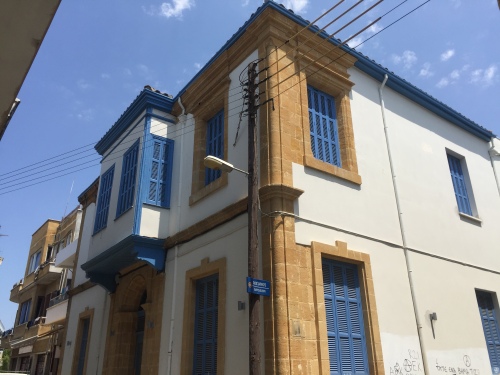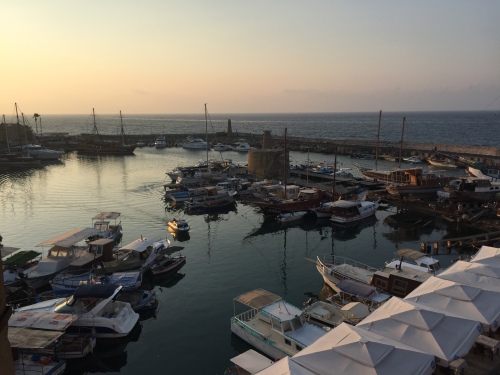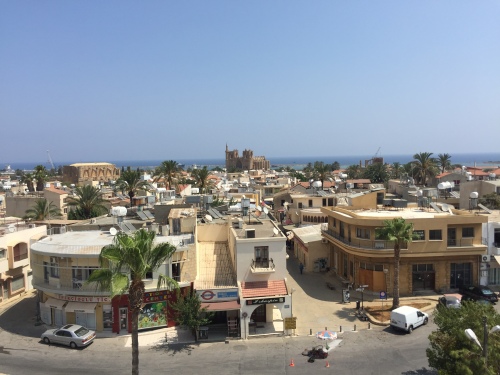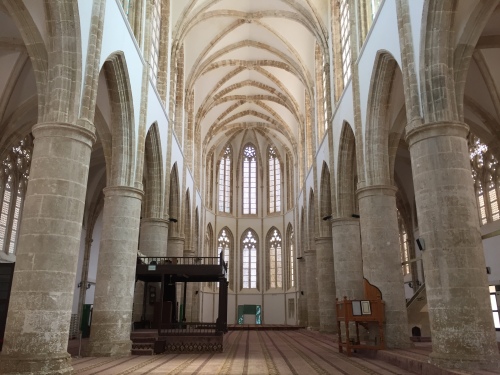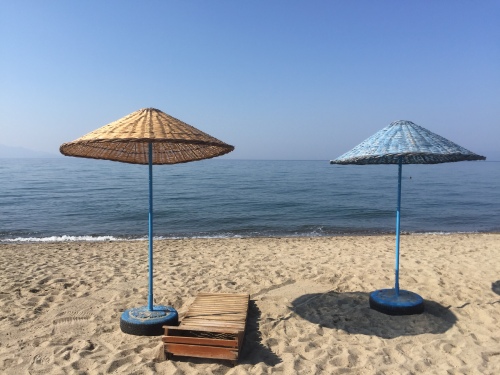Notes from the Middle Sea: Cyprus to Turkey
V.
I flew to Cyprus. The reason I flew to Cyprus was fairly inane: I was sick of flying so much. I figured, if I couldn’t get out of Lebanon overland—the north and east of the country blocked off by the disaster zone that is Syria, a hostile Israel to the south—I might as well fly to the closest possible overseas airport and proceed in a more lowly fashion from there. So Cyprus it was, a scandalously brief leap west, over the Mediterranean, culminating in a descent onto the sun-scorched, cacti-dotted fields outside Larnaca.
Having arrived in the Republic, I immediately began to leave. By bus this time, skipping across the desiccated landscape fringed by pebbly hills, towards Nicosia, the island’s divided capital, the bus buffeted by hot winds whipping across the plains. Aegean Airlines’ in-flight magazine had left me in no doubt that in shunning the island’s southern (Greek) portion, I was missing out on some delightful places. On the other hand, I had limited time and needed to book passage to Turkey; Cypriot ferry companies having seemingly not yet digitized their Turkey offerings, I would have to go to where the boats were.
To get there, I walked through Nicosia, crossing the border at the demilitarized zone on Ledra Street (a pedestrian mall at the heart of Greek Nicosia). This “green zone,” inaccessible to civilians for over 40 decades, cuts a swathe across the country, taking up around 4% of the island’s surface area. Traveling across it—showing my passport, being waved along—I felt a strangely muted sense of transference; it was one of the most relaxed border crossings I’ve ever passed through (the ease that characterized my experience is also born of privilege. A small sign affixed to the entrance advises refugees that their papers allow them access to only one section of the island).
Simple as the movement might be, the difference between the two Nicosias is surprisingly stark. In the south, Ledra forms a spacious artery smoothly passing through the heart of the old walled city: a manicured avenue, lined with international stores and upmarket eateries, where people browse for Birkenstocks and pay with euros. In the north, the road diverges into a maze of winding alleyways: bits of run-down bazaar, a crumbling Armenian quarter. If one was looking for an architectural illustration of how 19th century Orientalist scholars visualized the difference between the Occidental and the Eastern mind, this yin-yang division of Nicosia would be an excellent place to start.
But for someone coming straight from Beirut—another divided city, despite its nominal unity—Nicosia seemed remarkably free of scar tissue. This, one assumes, must be mostly due to good refurbishment, since battles were fought in various neighborhoods and the city was a target of Turkish airstrikes (bullet holes and battle damage are more evident inside Cyprus’ untouched “green zone”). Forty years on from the Turkish intervention (or invasion, depending on whom you ask), talk of reunification is now ramping up. You wouldn’t know it from the rhetoric on the ground. On the Turkish side of Nicosia (known as Lefkosa), a “Museum of Barbarism” is dedicated to examining the war etiquette of their opponents. Information posted in the south refers to the Turkish zone as “occupied areas.”
But Cyprus—like the other major islands of the Mediterranean, those vital lands in the middle of the Middle Sea—has long been a contested space. Assyrians, Egyptians, Persians all passed through, followed by the shooting star of Alexander the Great, and the return of Egyptian rule following his death (under the Macedonian Ptolemies). Then came the Romans (Classical and Eastern), the Arabs, French Crusaders followed by the wily Venetians and the long reign of the Ottomans. Over the Ottoman centuries, Muslim and Christian communities remained resolutely unmixed; divided by religion and language, the populations lived side-by-side but separate, despite the island’s characteristically hodgepodge Levantine stew of Greeks, Venetians, Armenians, Syrians, Jews and Copts.
(Now, the island’s demographics are shifting again, with newcomers arriving from the Middle East, Africa and South Asia—although Cyprus, with its stringent refugee policy, likely wielded as a deterrent, is hardly a desirable destination for asylum seekers. In 2014, one boatload of Syrians, clearly blown off course, refused to disembark at Limassol and demanded instead to be taken to Italy.)
Kyrenia (known in Turkish as Girne), the small town I land up in, on the island’s northern coastline, has been stamped with the seal of successive invaders. The handsome stone fortress presiding over the port was built in the era of Byzantium, inhabited by the Crusaders, and modified by the Venetians. The historic harbor it overlooks—a stone crescent rimmed with restaurants and filled with small sailboats—was once the center of the island’s booming carob trade, and is now Kyrenia’s tourism hotspot: at night, Russian and Turkish vacationers eat grilled fish and meze, and wander out along the long breakwater to gaze back at the castle, the moon, the stars, the bright lights of the little town.
In some (shallow) ways, northern Cyprus seems to me a mirror image of Sicily: in the latter, Islamic flourishes on Christian buildings visually draw the island out of Europe, anchoring it at the changeable center of a spinning wheel of civilizations. Here, at the eastern reaches of the Med, is a Muslim exoskeleton built over the flesh of former faiths: Greek Orthodox and French Crusader churches have been left standing, adapted to a new religion with the addition of a minaret and plenty of carpet.
This is most evident at Famagusta, a city on Cyprus’s east coast. Venice’s military headquarters up until the late 16th century, the old town is encircled by thick Venetian walls. Carob trees guard one of the stone bridges stretching across the fortifications’ dry moat, dropping long curling beans onto the flagstones. I crunch on one of the sweet leathery pods, spitting out amber seeds, as I cross, and scramble up the ramparts for a better view.
Midway between the walls and the sea, the city’s beautiful ruins dominate Famagusta’s heat-hazed, water-edged skyline: the decaying remains of a Venetian royal palace crumble away opposite a mammoth Gothic cathedral—legacy of the Lusignans—that has been repurposed as a mosque. Two chapels nearby attest to the presence of both the Knights Templar and Knights Hospitaller. A small Greek church to the south is studded with cannon fire. Fig trees, pomegranates and cacti claw their way up, through the dry earth and the old stone, to drop fruit on ancient paths.
On my final morning on the island, I jog up into the hills behind Kyrenia, past ugly subdivisions, budget hotels and quiet suburbs, to reach Bellepais: a hulking monastery clinging to the side of the mountain, the windowless stone wall of the abbey seemingly hanging in space. In its protected courtyard, an ancient fig and mulberry tree have grown over centuries, one entwined around the other, fused together by time and proximity, until they seem to form one living being.
That night, I board a boat heading north.
VI.
Less than a month before I arrived at Silifke, a small town on Turkey’s Mediterranean coast, the country was rocked by a coup attempt. Wedged between Europe and the Middle East, riven by internal tensions and sharing a border with two failing states, Turkey has been grappling with multiple challenges (terrorist attacks in metropolitan areas, an ongoing and increasingly bloody conflict with the PKK in the southeast, an influx of several million refugees, and an increasingly polarized populace to mention only a few). The putsch still seemingly came as a shock to most observers, but President Erdogan’s immediate response was eminently predictable: mass arrests, widespread dismissals, a travel lockdown, fiery rhetoric—all in the service of a seemingly indiscriminate “purge” to rid the country of opposition elements.
The potent, incoherent mix of fear, instability, frustration, heightened state control and nationalist euphoria that the coup occasioned was essentially invisible as I travelled diagonally across the country by bus, winding over mountains on a road lined with fig stands and honey venders before hitting the flatlands of central Anatolia. A brief sleep in the bus station of Izmir (Turkey’s smuggling mecca), followed by two short rides north, brought me to Dikili—a sleepy beach resort and retirement community tucked into a nook just north of a small promontory nosing out into the Aegean Sea.
One of my friends owns a holiday home in Dikili, which is how I’ve ended here, but the town’s name is most familiar to me as the Turkish port to which rejected asylum seekers in Greece are deported, under the terms of the deal struck in March between Erdogan’s government and the European Union. The deal got off to a bad start—when I was at Idomeni, we read reports of asylum claims inadequately reviewed, the supposed ratio of 1 returnee : 1 relocation completely disregarded—and by the time I reached the Aegean, I had heard no news of refugee returns for months.
Each morning in Dikili, I made my way down to the nearest stretch of blonde, umbrella-dotted sand, and gazed at the horizon for several minutes before stepping into the water. The dark blue haze of Lesvos loomed up from the waves, surprisingly close. If a ship of deportees were to make its way across, I reasoned, unreasonably, it would likely be in the early hours, and I’d have a good chance of spotting it. I never did see one—although I did once spot a navy frigate, patrolling—and a friend based in Thessaloniki told me that the most recent returns were made by air, to a different, undisclosed location. I kept a lookout regardless, fruitlessly scanning the gentle blue swells, for a vessel I would have no means of identifying.
That dark Greek coastline in the distance mesmerized me each morning as I swam towards it, through cool, translucent Aegean wavelets, marveling at how welcoming was the water of this sea. This time last year, I was on Lesvos, gazing back in the opposite direction, trying to spot the small inflatable boats leaving regularly from the Turkish shore. The sea seemed less benign then: a dark barrier, easy whipped into a white-frothed frenzy, that swallowed many travelers and indiscriminately terrified the people arriving, soaked but alive, on the island. It is strange now to wade into the same water, to let it wash over my skin, to extract pleasure from the experience—aware that all the bodies have not yet been found, that boats (not many, but some) still make the dangerous journey, that people are living in what amount to holding pens on the nearby shore.
But the sea is alluring, addictive, an idyll. This is the first time I have ever swum in the Mediterranean, and I see why this body of water—once a strategic battlefield, a lucrative trading network, a crucial means of communication—becomes each year more of a playground. The Med’s glamour—its easy fluidity, cozy closeness, its leisurely whisper—is, of course, deceptive. This sea is still a locus of pain and despair, still the centre of an important human story, or many, many millions of them—at once a cruel barrier and a slippery conduit. To see it simply as a pleasure ground would be myopic, demeaning, I remind myself each time I strike out into the waves—but is it wrong to take pleasure in its very real beauty?
Here, in the northern sub-divided reaches of Dikili, not so far from the ancient site of Troy and the blood-soaked cliffs of Gallipoli, history appears only in the form of the craggy fruit trees (mulberry, fig, plum, pear) that line roads, adorn gardens. New blocks of holiday homes are springing up, ugly concrete carapaces scarifying scrubby vacant land, the noises of construction on the breeze. Some people, doubtless, have been coming here for years, escaping Turkey’s rapidly expanding metropolises for their own little slice of the Mediterranean dream, adding their micro-histories to the tapestry of stories woven into the life of the Middle Sea. The softness of the sunsets, the hazy light, the pastels at dawn, connect Dikili to Beirut to Istanbul to Alexandria to Salonica to Syracusa.
Now, as I write, some weeks after leaving Dikili, and just less than a year after first arriving on Lesvos, the number of refugees making the treacherous Aegean crossing has jumped—ending, perhaps, the lull imposed by the Turkey-EU deal (although the numbers are still far lower than at this route’s height). These new arrivals will be held, like many thousands of others, on the islands—their progress into mainland Greece impeded while their asylum applications are checked, at a glacial pace. Those whose applications are rejected will face deportation back into Turkey, officially designated a “safe third country” despite manifest evidence to the contrary.
Moria—one of the holding camps on Lesvos that over the months of its existence has managed to transform the island’s idyllic olive-strewn slopes into a barbed wire-festooned, over-crowded purgatory—has just gone up in flames, sending 4000 men, women and children fleeing from its gates. The camp’s inhabitants (primarily Syrians, Afghans and Pakistanis) were already spooked by rumors of an impending mass deportation to Turkey. They are just a fraction of the 60,000 refugees currently stranded in Greece.
The extent of the crisis has done little to deter tourists, with a much-needed summer holiday boom boosting the country’s fragile economy as travelers flock to scenic coastlines and rustic villages. Outside of the camps, in the cobbled lanes of Oia or the turquoise beaches of Paros (or, for that matter, in a conference hall in New York, a bar in Sydney, a hookah cafe in Beirut), it’s possible to ignore the human suffering brought in on the temperate seas—it’s easier to forget than to remember that here, in the insolvent, unstable paradise of the eastern Mediterranean, we have built an archipelago of little hells.


